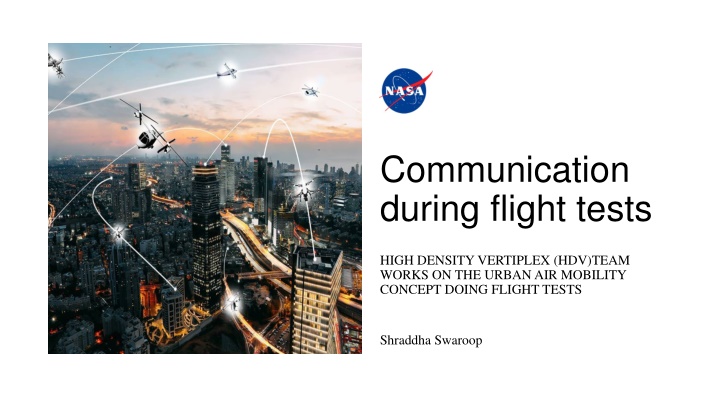
Urban Air Mobility Concept: Data Visualization Tool Development
"Explore the development process of a data visualization tool for High Density Vertiplex (HDV) team working on urban air mobility. Discover user pain points, goals, and human factors methodologies implemented in creating a user-friendly tool by leveraging qualitative research and user interviews." (286 characters)
Download Presentation

Please find below an Image/Link to download the presentation.
The content on the website is provided AS IS for your information and personal use only. It may not be sold, licensed, or shared on other websites without obtaining consent from the author. If you encounter any issues during the download, it is possible that the publisher has removed the file from their server.
You are allowed to download the files provided on this website for personal or commercial use, subject to the condition that they are used lawfully. All files are the property of their respective owners.
The content on the website is provided AS IS for your information and personal use only. It may not be sold, licensed, or shared on other websites without obtaining consent from the author.
E N D
Presentation Transcript
Communication during flight tests HIGH DENSITY VERTIPLEX (HDV)TEAM WORKS ON THE URBAN AIR MOBILITY CONCEPT DOING FLIGHT TESTS Shraddha Swaroop
Project: Data visualization tool for the High Density Vertiplex (HDV) team Goal: Provide researchers with a tool for easy access to data visualization to provide accurate, effective and full understanding of the live flight and simulated flight research that is done on a semi-annual basis. This tool will provide data-driven solutions for air traffic management system for the HDV project High Density Vertiplex
Objectives Generate a list of common pain points and goals of users that may impact the development of data visualization tool by October 2022 will allow me to create an easy-to-use tool. Activity: Interview 5 key users of the last live flight test to understand workflow analysis for both tech leads and researcher groups Generate Develop prototype by November 2022 based on the needs of the users to provide a tool to help them improve team situation awareness to keep flight tests on track. Activity: Create mockups that will be part of the prototype that will be created using Adobe XD Develop
Human Factors Methodologies Use Adobe XD prototype to test 6 participants 4 task of varying difficulty Measuring user perception, response time and task difficulty Interviews will reveal current workflow. Examine problems and inefficiencies. Work flow analysis: Usability test:
Timeline Novemb er Decembe r August Sept October Wrote user interview script Conducted user interview Created personas Wrote recommendations and requirements based on qualitative research Wrote report Wrote test plan for usability test Ran usability test (n=6) Wrote technical report Introduced to team Requested access to Grafana and Matlab Wrote goals, objectives and activities Developed user scenarios User profiles
User research Qualitative research: User interviews with tech leads and researchers. Lead to discovery of new problem when 60 percent of the participants said they had problems with communication Synthesized research with affinity mapping Created personas for both groups
Usability test Quantitative research: Created test plan Participants (n=6) did a series of 4 tasks of varying difficulty on an Adobe XD prototype designed to increase team situation awareness. Developed and implemented consent form, demographic survey, open-ended questions and used the standard System Usability Survey (SUS) in a recorded Teams call session.
System Usability Survey System Usability Survey Ratings by Participants This is a self-rating on ease of use, efficiency and effectiveness for the communication tool Scores over 70 indicate acceptable usability Scores between 50 and 70 indicate marginal usability The mean score for this test is 84. 100 90 System Usability Survey Scores 80 70 60 50 40 30 20 10 80 75 80 97.5 90 80 0 1 2 3 4 5 6 Participants
Response Time Average response time by task compared to optimal times 90 85 80 70 Response Times All times are under two minutes, the criteria for failure Task 1: GCSO logs in obtains security clearance Task 2: Find upcoming task for Range Safety Officer Task 3: Find upcoming task for your role Task 4: Check off doing your task 60 59 50 40 30 20 22 20 10 6 6 5 4 0 Task 1 4 22 Task 2 6 59 Task 3 5 85 Task 4 6 20 Optimal Time Geomean Tasks
Task Difficulty Self-reported Task Difficulty 5 4.8 4.8 Self-rating on task difficulty 4.6 Each task was rates on a scale of 1 to 5 with 1 being very hard and 5 being very easy Task 3 and 4 s score correlates to the difficulty that 3 out of 5 participants had navigating to the My Tasks page 4.4 4.3 4.25 4.2 4 4 3.8 3.6 1 2 3 4 Average scores of difficulty by task
